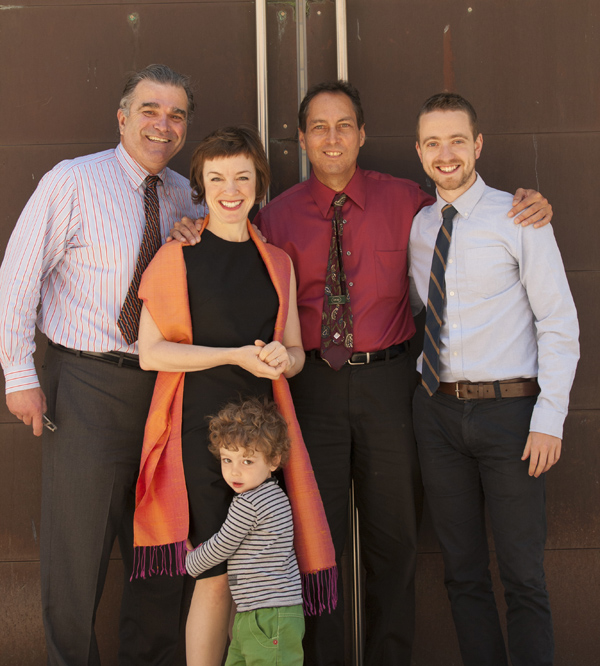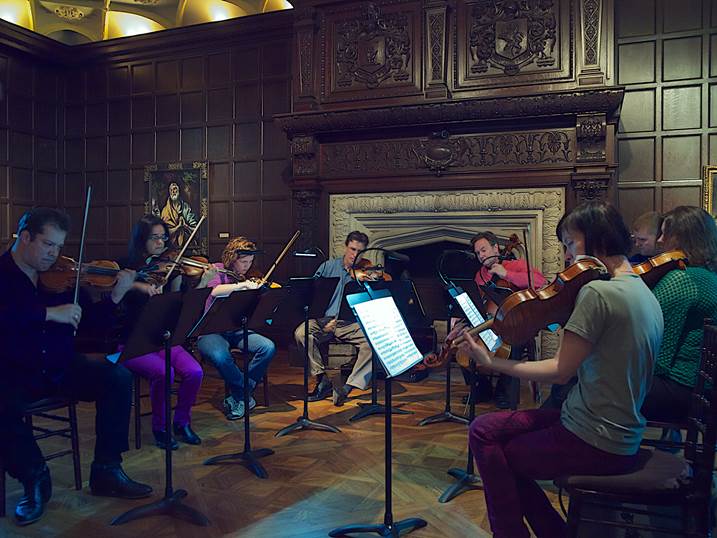We would like to take the opportunity to thank all the performers, volunteers, Concertmasters, supporters, and audience members for making a successful 2012/2013 concert season. See you in October! In the meantime, you can find podcasts of our recordings on iTunes.
Category Archives: Phillips Music
The Audacity of Youth: Teenage String Octets
On Sunday May 26, in the concluding concert of the 2012/2013 season of Sunday Concerts, The Phillips Camerata performed a program of string octets by Felix Mendelssohn and George Enescu. It was a first in the museum’s musical history to present eight string musicians and a unique opportunity to hear works written for this unusual form. The rich combination of strings produces a compelling sonority in any acoustic, but in the intimacy of the wood paneled Music Room, these two wildly contrasting works were heard up close and personal, with all their depths and intricacies on view.
The repertoire for string octet, (a double string quartet consisting of four violins, two violas, and two cellos) is unhappily slim. Octets and septets for woodwind instruments, or string and wind combinations, have enjoyed a happier life in the classical canon. There may be good reasons for this: how do you control eight string voices individually and as a whole? Does the lack of other orchestral instruments lead to a shortage of musical color at the composer’s disposal? Whilst these may be valid questions, perhaps the short answer as to why neither Mozart, Beethoven, nor many other great masters attempted the string octet is quite simply because they never got around to it.
Why then that the 16-year-old Mendelssohn and 19-year-old Enescu decided to turn their hands to the form is intriguing. Both composers were child prodigies and crafted these works in their teens. A delicate time for even the most prodigious composer, many of the teenage works of the great composers hardly attest to the image that genius emerges on the scene fully formed. Many of these early efforts are condemned to the drawer, stripped of their themes and recast with renewed grandeur, or destroyed in fits of Byronesque self-recrimination. However, both Mendelssohn and Enescu managed to compose music that remains compelling irrespective of its adolescent, hormonally-charged origins.
The two works offer vastly different sound worlds. Mendelssohn’s Octet in E-flat Major sparkles with originality and the work’s four movements showcase his consummate skills as a composer. He seamlessly combines fugue and counterpoint, complex orchestral textures, and tapestries of interweaving themes, which continually surprise and engage the listener. Throughout this piece you can feel Mendelssohn’s joy in having found his voice. After the first performances of the Octet his name began to be uttered in the same breath as the great masters.
Enescu’s world is decidedly more dramatic and emotionally charged. Influenced by the folk music traditions of his native Romania, Enescu drives a raw almost primitive quality through the heart of his Octet in C Major, written at the turn of the 20th century. Approaching this form was an endeavor Enescu took very seriously, almost to the point of torment, writing, “No engineer putting his first suspension bridge across a river can have agonized more than I did as I gradually filled my manuscript paper with notes.” This strength of purpose is apparent from the very first notes of Enescu’s Octet, which plunge us into an unsettling world, charged with a powerful sense of pathos.
Both of these works exhibit the hallmarks of maturity, yet retain the probing and inquisitive sense of youth. They demonstrate the meticulous and hard fought transition from child prodigy to established artist, and carry forth a clarity of musical vision that remains as rich and artistically vibrant as it did when these works were heard for the first time.
Jeremy Ney, Music Consultant
What’s the big deal about Beethoven?

Albert André, The Concert, 1903. Oil on cardboard on wood panel,. 20 3/4 x 26 3/4 in. The Phillips Collection, Washington, D.C. Acquired 1923
Last Sunday, The Phillips Camerata began its five-concert exploration of Beethoven’s piano concertos, in collaboration with resident musicians from the National Gallery of Art. In the space of a few weeks, all five concertos will be performed at our two institutions in a project that explores the depth and scale of these great works in arrangements for chamber ensemble. Camerata pianist Irina Nuzova began the cycle on Sunday with Piano Concerto No. 1, followed by Piano Concerto No. 2 performed at the National Gallery yesterday afternoon with soloist Edvinas Minkstimas. Concertos 3-5 will be performed respectively by pianists Danielle Deswert Hahn (April 7 at 6:30 pm at the National Gallery), Thomas Pandolfi (April 14 at 4 pm at The Phillips Collection), and Mykola Suk (April 21 at 6:30 pm at the National Gallery).
What does Beethoven offer us in these works? Almost always a journey of some kind. If we trace an arc from the first to the last concerto, we can see the enormity of Beethoven’s musical achievement. This can also be found in his 32 piano sonatas, 16 string quartets, and in the symphonies, but never is this voyage so uniquely distilled as it is in the piano concertos. By the time he had completed the first concerto, aged 28, Beethoven had established himself in Vienna as the preeminent keyboard virtuoso of his age. He had absorbed the influence of Mozart and Haydn, and this is evident in his first two concertos. Yet having done so in his 20s, he wanted to show himself as more than the inheritor of their tradition, rather as a revolutionary, dragging the coattails of courtly Viennese society into the dawn of a new musical age. By the third concerto, composed in 1800, it is clear that he was trying something totally new and never before heard.
It was a timely shakeup of the status quo. Until the arrival of Beethoven, composers were largely expected to fulfill obligations to patrons and aristocracy, and music was the gilded flower of social elites. However by the late 18th century the system began to break down–music was being written for a broader audience and published and sold more widely. It was becoming universal. Beethoven’s passionate and explosive new music grasped the spirit of his epoch; truly a man of his time, Beethoven’s compositions elevated music to new levels of expression.
Beethoven the man was a complex and contradictory character, however. He was often gloomy, dark, and intolerable. He detested crowds, led a miserable love life, and through his growing deafness suffered the greatest affliction imaginable for a musician. Yet it was precisely through this adversity that he channeled his art, communicating incredible hope, positivity, and warmth. Our fascination with his life is because his music takes us on an intimate journey through it; we share in his joys, loves, and pains in equal measure.
Jeremy Ney, Music Consultant


